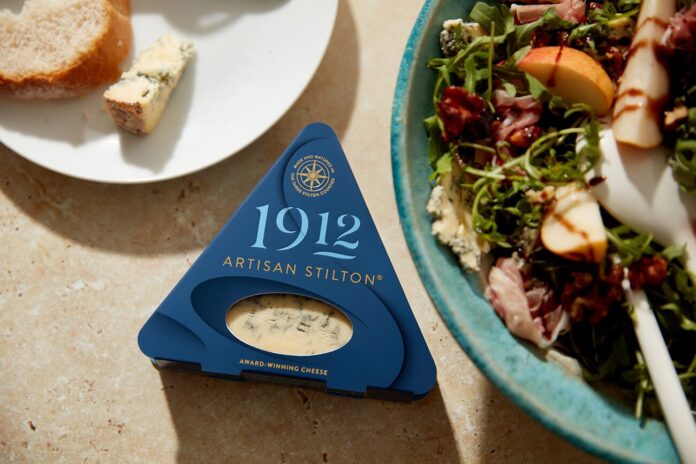Solely six locations within the three English counties are licensed to supply the King of English cheeses. 4 of the licensed dairies are based mostly within the Vale of Belvoir. Stilton’s provenance is Derbyshire, Nottinghamshire, and Leicestershire.
Colston Bassett Dairy was established as a co-operative in 1913, now run by Billy Kevan, Thye creamery nonetheless hand-ladles its cheese. Cropwell Bishop Creamery was based in 1847and remains to be run by the Skailes household. Tuxford and Tebbutt, which additionally used to make pork pies again to the 1780s, Webster’s Dairy in Saxelby close to Melton Mowbray, and Shirevale are all allowed to make Blue and White Stilton from milk and penicillium roquefortine.

A brand new Blue Stilton has simply been made by the opposite acknowledged Stilton cheese maker, Lengthy Clawson. It’s new first branded “1912 Artisan” commemorates the date when the corporate was based as a farming collective, making cheese from over thirty native provider farms.
MD Invoice Mathieson desires to maneuver the “nationwide treasure” of Stilton away from the cheeseboard in direction of turning into “a core product” in UK households with “a rise in utilization events.” It isn’t a particular deal with to take pleasure in at Christmas.
“There’s a recession coming and there can be extra in-home moments to eat Stilton. It’s at present wedded to the cheeseboard, with individuals, on common, solely consuming Stilton 3 times a 12 months.”
Given greater than 60% of customers used cheese as an ingredient, Mathieson says there may be “an enormous alternative to double the market over the following 10-15 years as a extra on a regular basis ingredient for snacking and in recipes”.

The brand new Stilton was made with milk sourced from cows grazed for not less than 180 days a 12 months on the 30 farms that personal the Lengthy Clawson co-op. Cheddar cheese from Somerset may return to 1170 and Wensleydale cheese to the twelfth-century Yorkshire monks. However semi-soft Stilton is probably the most English of English cheeses. It takes its identify from a village in Cambridgeshire however cheese made in Stilton can’t be lawfully referred to as Stilton because it’s within the unsuitable county. Cream cheese was being made and bought in and across the village because the late seventeenth century. Information present that, in 1726, the Stilton got here in seven-inch diameter, eight-inch deep 18lb wheels. It was made with entire milk to which cream was added.

In his 1724” A Tour via the Entire land of Nice Britain, Daniel Defoe wrote, “We Cross’d Stilton, a city well-known for cheese, which is known as our English Parmesan, and is delivered to the desk with the mites and maggots spherical it, so thick, that they create a spoon with them so that you can eat the mites with, as you do the cheese.”
Early Stiltons have been in all probability arduous cream cheese pressed and boiled in its whey. A recipe for Stilton cheese was revealed in 1726 by Richard Bradley, who was to grow to be Cambridge College’s first Professor of Botany.
In response to the English Stilton Affiliation, shaped in 1936, the primary individual to market Blue Stilton cheese was Cooper Thornhill, proprietor of The Bell Inn in Stilton on the Nice North Street London-Edinburgh stagecoach route. You’ll be able to nonetheless keep within the inn close to Peterborough in outdated Huntingdonshire.

In 1743, Thornhill entered right into a business association with Frances Pawlett, a famend cheesemaker from Wymondham in Leicestershire.
It’s unclear whether or not the blue veining was then achieved via frequent brushing of the maturing cheese, or whether or not the getting older cheeses merely cracked, permitting some to go blue and others not. Definitely, Thornhill and Pawlett commercialized Stilton though Mrs. Oriton, a farmer’s spouse from Little Dalby, claimed she made the primary Stilton cheese. In 1966 Stilton was granted authorized safety through a certification trademark, making it the one British cheese to be accorded that standing.
Blue Stilton’s distinctive blue veins are created by piercing the crust of the cheese with stainless-steel needles, permitting air into the core. Stilton should, if potential, use solely regionally produced and pasteurized milk. Have a conventional cylindrical form, and kind their very own crust. It should even be unpressed, have blue veins radiating from the middle, has a “style profile typical of Stilton” and have a minimal of 48% milk fats within the dry matter.
Different typical British blue cheeses are Oxford Blue and Shropshire Blue. Italy has inexperienced Gorgonzola whereas France has cow’s milk Fourme d’Ambert and ewe’s milk Roquefort. Denmark produces Danish Blue Cheese, and the Dutch make Ruscello.
White Stilton has no saprotrophic fungi put into it. It’s crumbly and creamy and used as a base for creating dessert cheeses and as a flavoring for chocolate.
In his Sonnet to a Stilton Cheese”, G.Ok. Chesterton wrote of “the excessive cheese by sons od fenland”. Stilton, the grandfather of all blue cheese, is now a world phenomenon.

